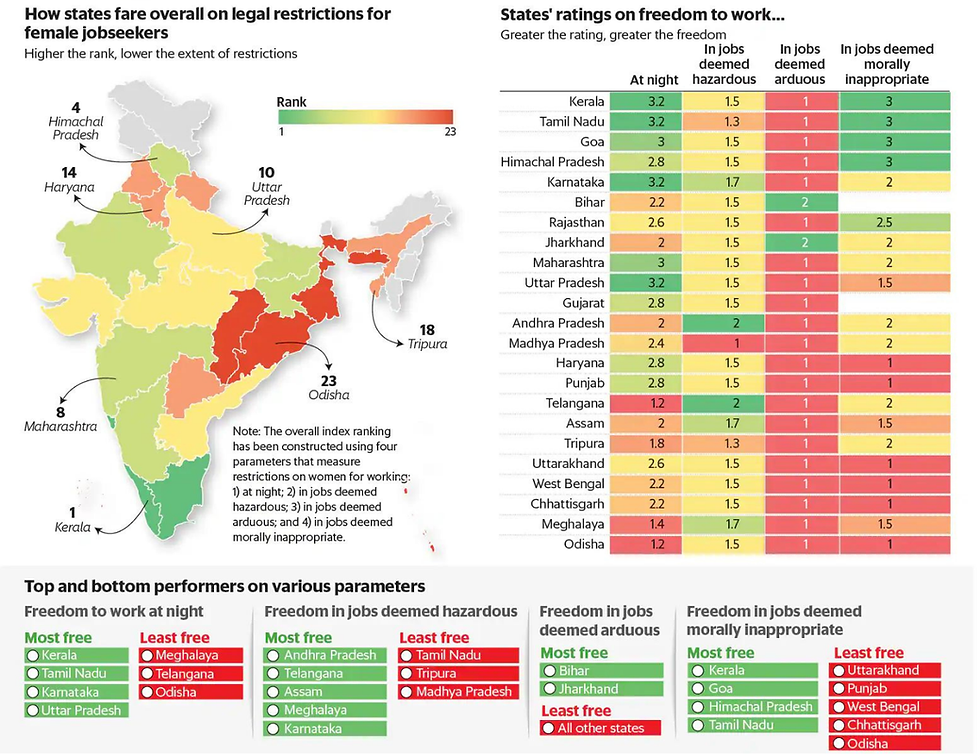At Work, Breaking Barriers
- connect2783
- Mar 7, 2024
- 3 min read
Updated: Jul 17
Women in India’s smaller cities are challenging traditions and embracing new unconventional roles, from businesses to tech and gig economy jobs. Career platforms and policies are opening doors, but are they enough to overcome the barriers? The rise of women entrepreneurs and professionals is reshaping the workforce, but what’s needed to ensure their growth and inclusion in the long run?

Sapna Sharma, a resident of Hapur, is a first-generation degree-holder who has established her entrepreneurial endeavor of selling Petha, a traditional Indian sweet. Women-owned businesses in smaller Indian cities, like Sharma’s, are utilising the MeraBizNet portal to receive mentorship and training to scale up. Launched in 2023, this portal has partnered with the credit agency CIBIL and the German government to extend support to such working women.
The career engagement platform, HerKey had reported a 58% year-on-year rise in registrations from women professionals seeking to return to work in Q1 2021, with a 65% increase in total registrations from Tier-II and III cities.
Such a trend indicates the growing presence of women from smaller cities in India’s workforce.Women are also participating in varied sectors and opting for unconventional roles, according to Apna, a professional networking platform.

In 2022, there was a 34% rise in women applicants for labour-intensive roles such as delivery, lab technicians, factory workers and drivers. Challenging the traditional gender roles, Meenakshi Devi became the 1st e-rickshaw driver in Chenab Valley’s Bhanderwah town. To support her family during financial turmoil and her husband’s illness, Devi defied odds despite facing society’s scepticism for taking up a non-traditional profession.
In the age of AI technology, women are also moving ahead with the times. NextWealth is a prominent company in this sphere, with established centres in Mallasamudram, Chittoor, Hubli, Bhilai, Mysore, Vellore, Pondicherry, Salem, Jaipur and Udaipur. NextWealth has employed nearly 5,000 individuals, out of which 60% are women. Contributing significantly to the tasks of data labelling and annotation, women workers in this sector are growing in numbers.

Transforming the country’s socio-economic landscape, women from smaller cities have been enabled by a multitude of factors: the proliferation of flexible work options post-COVID-19, the emergence of supportive platforms online, training programmes and sensitisation initiatives, along with the advent of technology-driven sectors.
While such tech developments and workplace enablers have been significant for women’s participation in the workforce, the Top Cities for Women in India (TCWI) Index emphasises the role of investment by city and state authorities for women’s sustained employment.
The 2nd edition of TCWI ranked cities based on their inclusivity for women across 3 parameters: social inclusion, workplace inclusion, and citizen experience. Among cities with a population of less than 1 million, 8 out of the top 10 were in South India – Tiruchirappalli, Vellore, Kochi, Thiruvananthapuram, Salem, Erode, Tiruppur, and Puducherry. Historical and social factors, along with enabling government policies of these cities contributed to their gender-progressive living environments. By utilising the Periodic Labour Force Survey, National Census, and crime records, along with Avtar Group’s primary research on women’s employment, the TCWI index findings highlight the importance of supportive city infrastructure for healthcare, education, childcare, and travel, for retaining women in the workforce.
In the era of contractual work, Urban Company (UC) - a home services platform has become the biggest employer of women in India’s online gig-economy. One-third of UC’s contract workforce are women, for whom it has symbolized a ticket to financial independence and social mobility. For women like Nishi Dhillon from Ambala, it also represents an opportunity to move away from their oppressive, caste-based work as reported by Rest Of World. However, there have been several instances of protest against UC’s working conditions, with contractual workers raising concerns over working hours and alleged unfair treatment.

In comparison to gig work, women’s participation in MSMEs is considerably low. A survey by BYST found that 85% of women entrepreneurs struggled to obtain loans from nationalised banks. Challenges like limited access to finance, property ownership and lack of collateral have hindered women’s participation.
To address the barriers in women’s work participation, gender-responsive policies become essential. Financial literacy training, increasing representation of women in leadership and supervisory roles, implementing work-integrated educational programmes, and building supportive infrastructure are a few crucial steps towards fostering a more inclusive workforce.
Does your city have a gender-inclusive workforce?
What measures do you think your city can take to improve women’s work participation?

Comments